We have already familiarized ourselves with the concept of self-attention as implemented by the Transformer attention mechanism for neural machine translation. We will now be shifting our focus to the details of the Transformer architecture itself to discover how self-attention can be implemented without relying on the use of recurrence and convolutions.
In this tutorial, you will discover the network architecture of the Transformer model.
After completing this tutorial, you will know:
- How the Transformer architecture implements an encoder-decoder structure without recurrence and convolutions
- How the Transformer encoder and decoder work
- How the Transformer self-attention compares to the use of recurrent and convolutional layers
Kick-start your project with my book Building Transformer Models with Attention. It provides self-study tutorials with working code to guide you into building a fully-working transformer model that can
translate sentences from one language to another...
Let’s get started.

The Transformer Model
Photo by Samule Sun, some rights reserved.
Tutorial Overview
This tutorial is divided into three parts; they are:
- The Transformer Architecture
- The Encoder
- The Decoder
- Sum Up: The Transformer Model
- Comparison to Recurrent and Convolutional Layers
Prerequisites
For this tutorial, we assume that you are already familiar with:
The Transformer Architecture
The Transformer architecture follows an encoder-decoder structure but does not rely on recurrence and convolutions in order to generate an output.
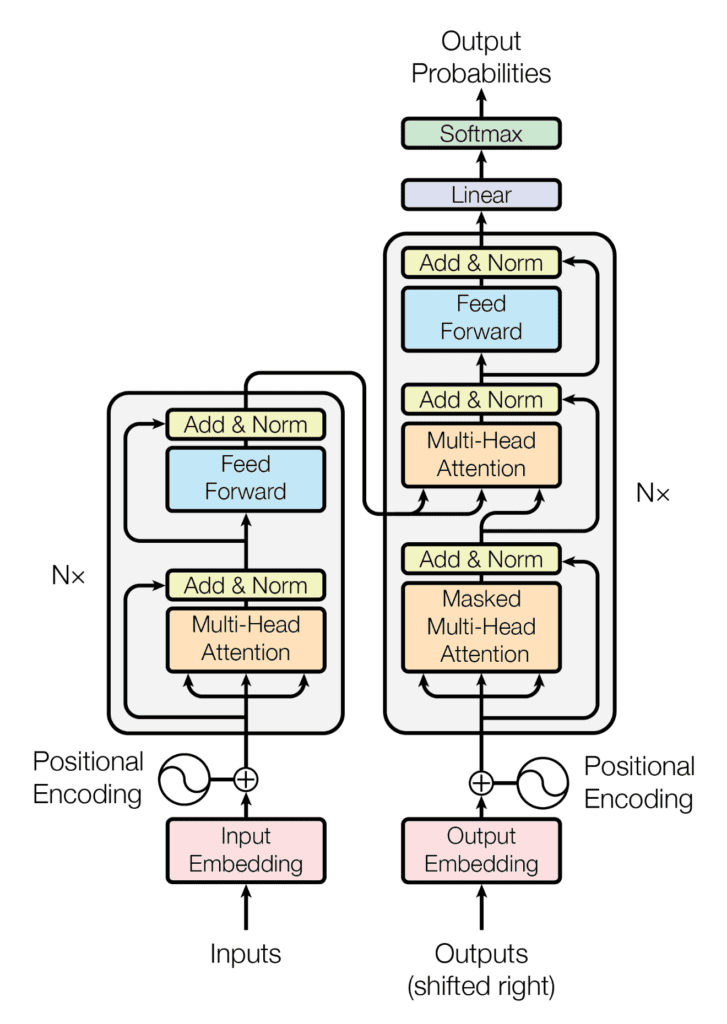
The encoder-decoder structure of the Transformer architecture
Taken from “Attention Is All You Need“
In a nutshell, the task of the encoder, on the left half of the Transformer architecture, is to map an input sequence to a sequence of continuous representations, which is then fed into a decoder.
The decoder, on the right half of the architecture, receives the output of the encoder together with the decoder output at the previous time step to generate an output sequence.
At each step the model is auto-regressive, consuming the previously generated symbols as additional input when generating the next.
– Attention Is All You Need, 2017.
The Encoder
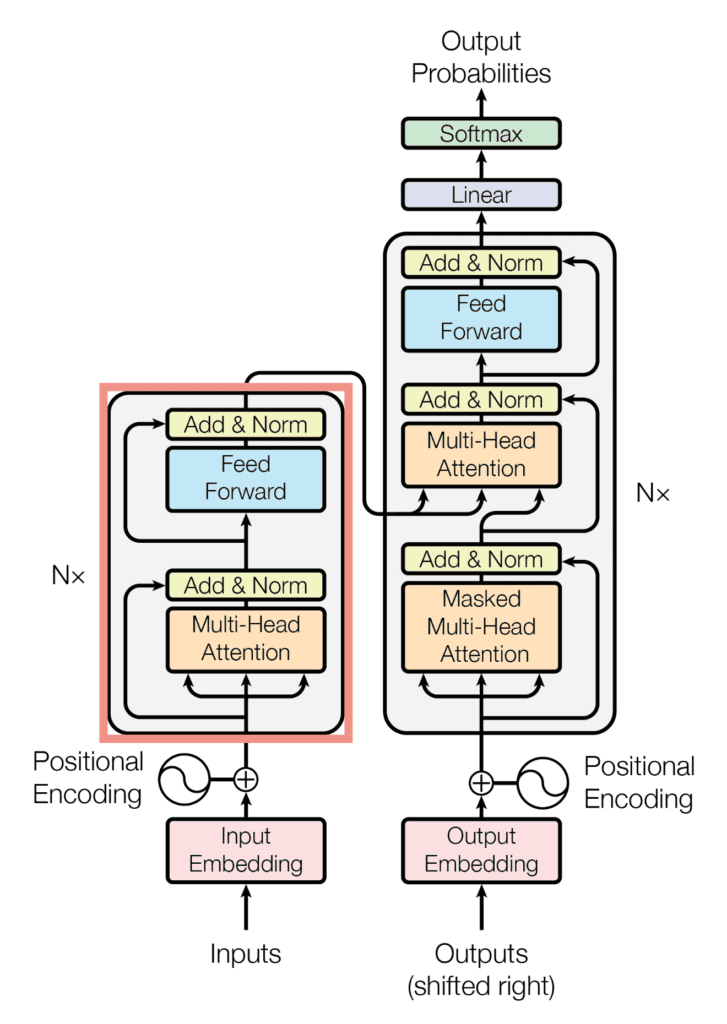
The encoder block of the Transformer architecture
Taken from “Attention Is All You Need“
The encoder consists of a stack of $N$ = 6 identical layers, where each layer is composed of two sublayers:
- The first sublayer implements a multi-head self-attention mechanism. You have seen that the multi-head mechanism implements $h$ heads that receive a (different) linearly projected version of the queries, keys, and values, each to produce $h$ outputs in parallel that are then used to generate a final result.
- The second sublayer is a fully connected feed-forward network consisting of two linear transformations with Rectified Linear Unit (ReLU) activation in between:
$$\text{FFN}(x) = \text{ReLU}(\mathbf{W}_1 x + b_1) \mathbf{W}_2 + b_2$$
The six layers of the Transformer encoder apply the same linear transformations to all the words in the input sequence, but each layer employs different weight ($\mathbf{W}_1, \mathbf{W}_2$) and bias ($b_1, b_2$) parameters to do so.
Furthermore, each of these two sublayers has a residual connection around it.
Each sublayer is also succeeded by a normalization layer, $\text{layernorm}(.)$, which normalizes the sum computed between the sublayer input, $x$, and the output generated by the sublayer itself, $\text{sublayer}(x)$:
$$\text{layernorm}(x + \text{sublayer}(x))$$
An important consideration to keep in mind is that the Transformer architecture cannot inherently capture any information about the relative positions of the words in the sequence since it does not make use of recurrence. This information has to be injected by introducing positional encodings to the input embeddings.
The positional encoding vectors are of the same dimension as the input embeddings and are generated using sine and cosine functions of different frequencies. Then, they are simply summed to the input embeddings in order to inject the positional information.
The Decoder
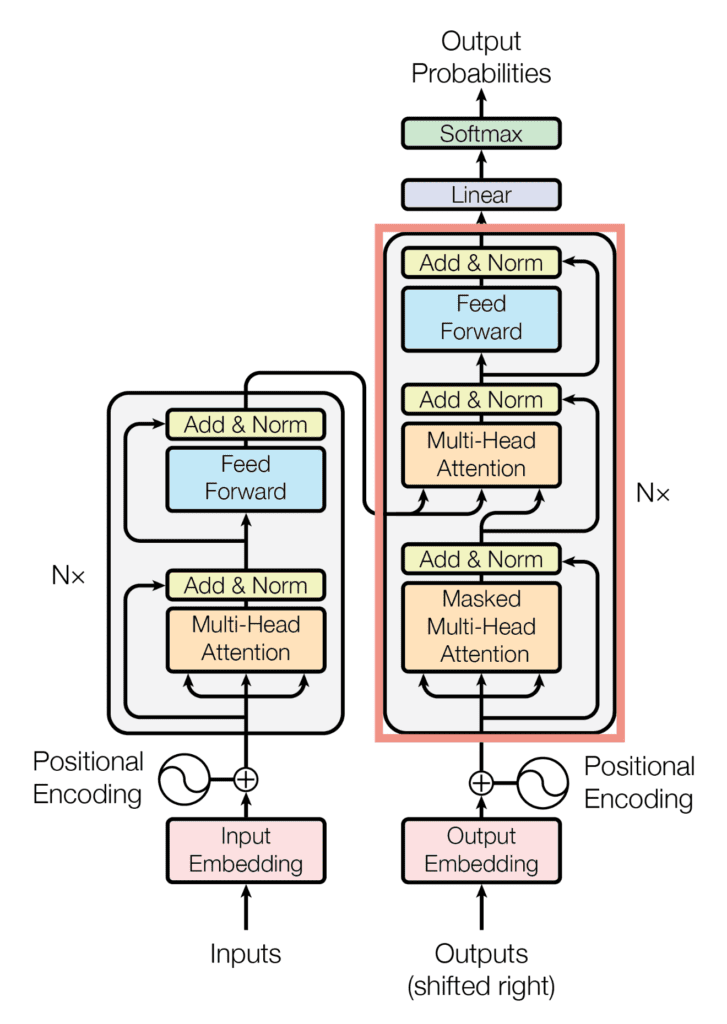
The decoder block of the Transformer architecture
Taken from “Attention Is All You Need“
The decoder shares several similarities with the encoder.
The decoder also consists of a stack of $N$ = 6 identical layers that are each composed of three sublayers:
- The first sublayer receives the previous output of the decoder stack, augments it with positional information, and implements multi-head self-attention over it. While the encoder is designed to attend to all words in the input sequence regardless of their position in the sequence, the decoder is modified to attend only to the preceding words. Hence, the prediction for a word at position $i$ can only depend on the known outputs for the words that come before it in the sequence. In the multi-head attention mechanism (which implements multiple, single attention functions in parallel), this is achieved by introducing a mask over the values produced by the scaled multiplication of matrices $\mathbf{Q}$ and $\mathbf{K}$. This masking is implemented by suppressing the matrix values that would otherwise correspond to illegal connections:
$$
\text{mask}(\mathbf{QK}^T) =
\text{mask} \left( \begin{bmatrix}
e_{11} & e_{12} & \dots & e_{1n} \\
e_{21} & e_{22} & \dots & e_{2n} \\
\vdots & \vdots & \ddots & \vdots \\
e_{m1} & e_{m2} & \dots & e_{mn} \\
\end{bmatrix} \right) =
\begin{bmatrix}
e_{11} & -\infty & \dots & -\infty \\
e_{21} & e_{22} & \dots & -\infty \\
\vdots & \vdots & \ddots & \vdots \\
e_{m1} & e_{m2} & \dots & e_{mn} \\
\end{bmatrix}
$$
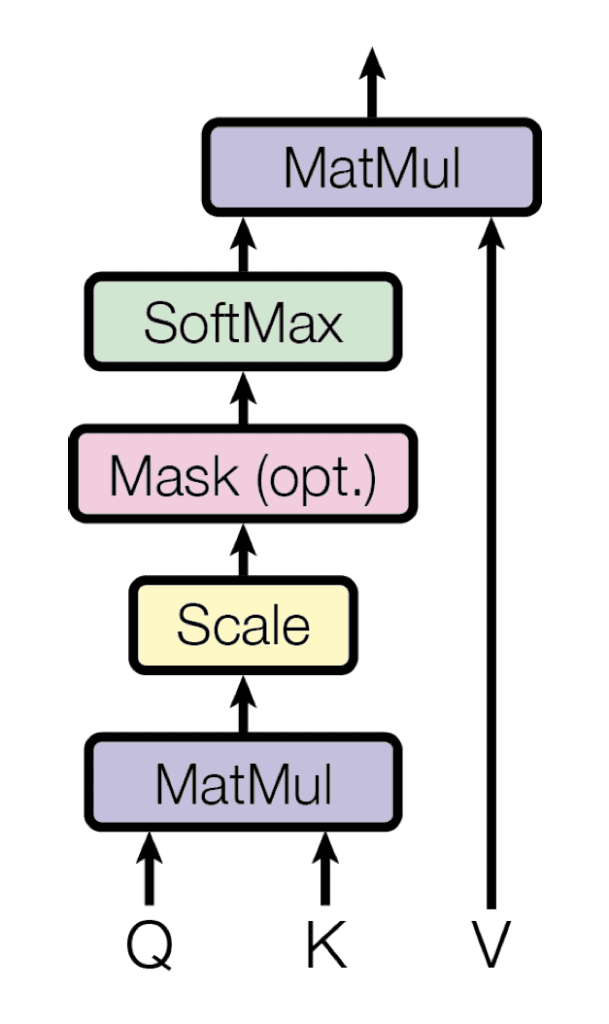
The multi-head attention in the decoder implements several masked, single-attention functions
Taken from “Attention Is All You Need“
The masking makes the decoder unidirectional (unlike the bidirectional encoder).
– Advanced Deep Learning with Python, 2019.
- The second layer implements a multi-head self-attention mechanism similar to the one implemented in the first sublayer of the encoder. On the decoder side, this multi-head mechanism receives the queries from the previous decoder sublayer and the keys and values from the output of the encoder. This allows the decoder to attend to all the words in the input sequence.
- The third layer implements a fully connected feed-forward network, similar to the one implemented in the second sublayer of the encoder.
Furthermore, the three sublayers on the decoder side also have residual connections around them and are succeeded by a normalization layer.
Positional encodings are also added to the input embeddings of the decoder in the same manner as previously explained for the encoder.
Want to Get Started With Building Transformer Models with Attention?
Take my free 12-day email crash course now (with sample code).
Click to sign-up and also get a free PDF Ebook version of the course.
Sum Up: The Transformer Model
The Transformer model runs as follows:
- Each word forming an input sequence is transformed into a $d_{\text{model}}$-dimensional embedding vector.
- Each embedding vector representing an input word is augmented by summing it (element-wise) to a positional encoding vector of the same $d_{\text{model}}$ length, hence introducing positional information into the input.
- The augmented embedding vectors are fed into the encoder block consisting of the two sublayers explained above. Since the encoder attends to all words in the input sequence, irrespective if they precede or succeed the word under consideration, then the Transformer encoder is bidirectional.
- The decoder receives as input its own predicted output word at time-step, $t – 1$.
- The input to the decoder is also augmented by positional encoding in the same manner done on the encoder side.
- The augmented decoder input is fed into the three sublayers comprising the decoder block explained above. Masking is applied in the first sublayer in order to stop the decoder from attending to the succeeding words. At the second sublayer, the decoder also receives the output of the encoder, which now allows the decoder to attend to all the words in the input sequence.
- The output of the decoder finally passes through a fully connected layer, followed by a softmax layer, to generate a prediction for the next word of the output sequence.
Comparison to Recurrent and Convolutional Layers
Vaswani et al. (2017) explain that their motivation for abandoning the use of recurrence and convolutions was based on several factors:
- Self-attention layers were found to be faster than recurrent layers for shorter sequence lengths and can be restricted to consider only a neighborhood in the input sequence for very long sequence lengths.
- The number of sequential operations required by a recurrent layer is based on the sequence length, whereas this number remains constant for a self-attention layer.
- In convolutional neural networks, the kernel width directly affects the long-term dependencies that can be established between pairs of input and output positions. Tracking long-term dependencies would require using large kernels or stacks of convolutional layers that could increase the computational cost.
Further Reading
This section provides more resources on the topic if you are looking to go deeper.
Books
Papers
- Attention Is All You Need, 2017.
Summary
In this tutorial, you discovered the network architecture of the Transformer model.
Specifically, you learned:
- How the Transformer architecture implements an encoder-decoder structure without recurrence and convolutions
- How the Transformer encoder and decoder work
- How the Transformer self-attention compares to recurrent and convolutional layers
Do you have any questions?
Ask your questions in the comments below, and I will do my best to answer.

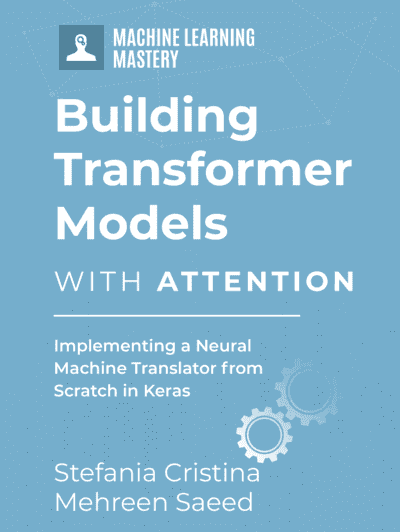






Hi Stefania Cristina, can you use the encoder block right away after taking convolved features from a backbone for object detection task excluding the decoder part?
Hi Kelvin, in the computer vision domain it is the encoder block that is usually used, which receives several image patches in parallel, plus the corresponding positional encodings. The encoder output is then typically passed on to an MLP for classification. However, I have also encountered architectures whereby the encoder block is preceded by convolutional layers, which first extract the image features before passing them on to the encoder.
Hi Stefania Cristina, Is it possible I use transformer model for time series classification? If it is ok, please guide me in coding. I’m a beginner in this field.
Thanks
Hi Saeid…You may find the following of interest:
https://towardsdatascience.com/multi-class-classification-with-transformers-6cf7b59a033a
In the text: “In convolutional neural networks, the kernel width directly affects the long-term dependencies that can be established between pairs of input and output positions. Tracking long-term dependencies would require the use of large kernels, or stacks of convolutional layers that could increase the computational cost”
I am not sure I get this paragraph correctly. The transformer model gets a sequential input e.g., text, audio etc. Similarly, tr o use text audio types of input in CNNs, we use 1-D convolutions, which use single dimension kernels where the width is always 1. In this case, we only configure the height of the kernel where I mostly use 4 or 7.
From my perspective, I think that statement is not a valid comparison.
Thanks for the article
Hi Furkan. The idea behind the attention mechanism is to draw global dependencies between the input and the output. This means that the process of predicting an output value will take into consideration the input data in its entirety (whether this is in the form of text, or an image etc). In this sense we can say that the Transformer can capture long-range dependencies, be it between words when these are distant in lenghty bodies of text, or pixels in distant parts of an image, etc.
In Vaswani et al.’s words, “A single convolutional layer with kernel width k < n does not connect all pairs of input and output positions. Doing so requires a stack of O(n/k) convolutional layers in the case of contiguous kernels…”, where n is the sequence length. In CNNs, the receptive field depends on the size of the kernel. If one would want to capture long-range dependencies in an image by a CNN, for example, one would either require a large 2D kernel (covering a neighbourhood of k x k pixels) to widen the receptive field as much as possible, or stack long sequences of convolutional layers, both of which can be computationally costly. When dealing with text, you would be working with 1D kernels as you mention, however your kernel width (you referred to it as height) will still define the size of your receptive field, which is often a local neighbourhood around each token in a sequence.
Thank you so much Sir, it’s really brief and understandable!
Please, Could you explain about image classification using transformers with codes?
Hi Imene…The following may be of interest to you:
https://paperswithcode.com/method/vision-transformer
Thank you for step by step explanation. Could you explain about prediction and anomaly detection in numerical data using transformers?
most of the sources are specifically for NLP
Hi sara…You are very welcome! The following resource is a great introduction to this topic:
https://medium.com/@moussab.orabi/enable-transformers-with-anomaly-detection-in-high-order-multivariate-time-series-data-509a5df39151
“The number of sequential operations required by a recurrent layer is based upon the sequence length, whereas this number remains constant for a self-attention layer. ”
— This doesn’t make sense, given that the Transformer model is itself limited in the input length? Transformer doesn’t allow to process arbitrarily long sequence with a constant number of operations 🙂
Hi Roman…The following may be of interest to you:
https://machinelearningmastery.com/the-transformer-attention-mechanism/
Hi Roman, the comment that you are referring to is not as much about the length of the input sequence, as it is about the number of operations that are applied to the input. To quote Vaswani et al., “As noted in Table 1, a self-attention layer connects all positions with a constant number of sequentially executed operations, whereas a recurrent layer requires O(n) sequential operations.”, where n is the input sequence length.
Having a look at Table 1 in Vaswani’s paper, we can see that the number of sequential operations for the self-attention layer is O(1), which means that it is not a function of the input size, as opposed to the number of sequential operations for recurrent layers. This is because, when the self-attention layer in the Transformer architecture receives its inputs in the form of Queries, Keys and Values, it will apply a set number of sequential operations to them, namely: dot-product multiplication between the Queries and Keys, followed by scaling (and masking, which is however optional), softmax normalisation, and one final dot-product multiplication with the Values (refer to the link provided by James for more details).
Hi Stefania,
Thank you very much for the nice and easy to understand article on the transformer model. However, to use transformer as a seq2seq model, I am curious to know how to add constraints to the encoder and/or the decoder. For example, the constraints might be the expected length of the output sequence. Thanks!
Hi Rashedur…The following resource may be of interest to you:
https://machinelearningmastery.com/encoder-decoder-attention-sequence-to-sequence-prediction-keras/
Hi James,
Thanks for your reply. In fact, I have an LSTM based seq2seq model to add the constraints (e.g. length of the output sequence). Now I am interested to use transformers (TransformerEncoder and TransformerDecoder) to add the constraint. But I don’t know how to do it with transformers.
@Stefania Cristina, I have a small doubt.I would be glad if you could answer my following questions.
@Any response from anyone would be appreciated.
Task: “Extractive/Abstractive Text Summarization using NLP with Transformer Model (Ex: T5 base model)”
1. What are the benefits of having multiple Encoder and Decoder block in Transformers although all encoder and decoder are identical by architecture?
2. As very 1st Encoder receives the input sentences in text summarization task and then processed input vectors transfer to 2nd Encoder and so on. So, what are the changes of these input vectors in 2nd to onward Encoders that comes from the 1st Encoder?
3. As per the Architecture, Last Encoder’s input vector representations moves to all Decoder, then what are the calculations happen in each Decoder block as all Decoders are in stacked by nature?
4. In English to English text summary, which input is fed into the Decoder block?Is it target summary? I am bit confused. If target summary is fed into the decoder, then what calculation will made between targeted summary input and encoder input?
5.Which part of the Decoder is basically responsible to choose words/sentences that will be part of the final summary sentences?
It would be really appreciated if anyone can help me to understand these queries.
Thanks in Advance.
Hi Hasan…Please narrow your query to one question so that we may better assist you.
hi Stefania,
how exactly is the transformer decoder not using for loops to predict its own word based on all previous predicted words?
I see that when training, the decoder iteratively predicts a next word with the final dense layer, which is done in parralel in training but I don’t understand how parrelel training works here.
Questions:
– are the input embeddings fed one by one to the encoder?
– the identical layers that form the encoder and decoder, are they in parallel or in series (do they process each the same copy of the input, or they are sequentially stacked)?
Hi Dario…The following resource may be of interest:
https://machinelearningmastery.com/lstm-autoencoders/
During the training process you have “output” data to feed your decoder.
But what happens during validation or test? You don’t know the output.
The picture is a Gunpla model rather than real transformer 🙂
Hi Stefania, Thanks for your tutorials on the topics of attention, transformers etc. I am new to this topic and found your tutorials quite useful to get a high level understanding. Can you please give any links to understand what queries, keys, values are. Thank you
Hi Peter…The following resource will hopefully add clarity:
https://stats.stackexchange.com/questions/421935/what-exactly-are-keys-queries-and-values-in-attention-mechanisms
Hello. can we use transformers for prediction in timeseries data? can you guid me a little bit?